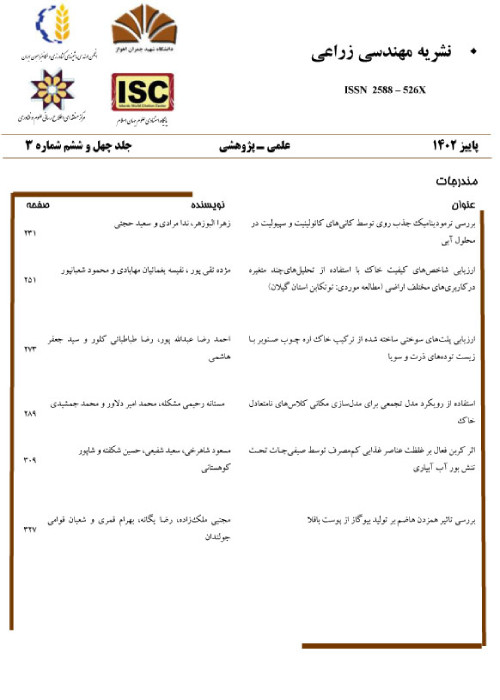Shear behavior definition of shrubs stem at pruning
Now cities are not comparable to the past for many problems such as air and sound pollution of factories and vehicles. Some natural systems such as parks help to keep the stability of cities and improve the life quality of urbanites. Privet with the scientific name of Ligustrum Ovalifolium is the evergreen plant, and widely cultivated at all of the parks in Iran. Privet stems are pruned by manual or gasoline -powered hedge trimmer. The knowing of the cutting properties of privet stalk have important role in the design and fabricate of privet pruning machine. A series of laboratory test was conducted to measure the shear force, shear consumption energy and shear strength of stem internodes of privet stalk under quasi-static and impact cutting at different loading rate, different internode position and moisture level 58% wet base.In the quasi-static cutting test, the stalk specimens were cut in the quasi-static process by using a computer aided cutting test apparatus at four loading rates: 5, 10, 15 and 20mm/min and three internode positions: fifth, tenth and fifteenth downward from the terminal bud. In impact test, the stalk specimens were served in impact process by using a cutting test apparatus was designed, fabricated, and calibrated at four loading rates: 1, 2, 3 and 4m/s and three internodes: fifth, tenth and fifteenth.
The study was performed to investigate the effect of quasi-static and impact shear on shear force, shear consumption energy and shear strength. The measured initial moisture content of the samples was 58% on wet base. The privet stalk diameter decreases towards to the top of the plant stalks. Thus, the stalks equally was divided into three regions downward from the terminal bud: (a) fifth internode, (b) tenth internode and (c) fifteenth internode. The quasi-static tests were conducted using the universal testing machine (SMT-5, SANTAM Co, Iran). The shear tests were carried out at four rates of speeds 5, 10, 15 and 20 mm/min. To determine the shear force of privet stalk, an impact cutting tester was designed, fabricated and calibrated. It was similar to an Izod impact cutting tester for metals. A cutting blade with sharpened angel of 23 degree and oblique angle of 60 degree was attached to end of pendulum's arm. The shear tests were carried out at four rates of blade speeds 1, 2, 3 and 4 m/s. A data acquisition system was attached to pendulum arm and it includes 4 strain gages and a digital indicator to show the real-time shear force. Four strain gages were contacted to each other by Wheatstone bridge circuit and were mounted on two sides of pendulum. After calibration, the impact shear force was applied to the privet samples by releasing the pendulum arm in the testing machine up to the sample failure. The real-time applied force and cutting time were measured by data acquisition system and chronometer.
In quasi -static cutting of the stalk specimens, the analysis of variance (ANOVA) indicated that the loading rate and interaction of loading rateinternode position have significant effect on the shear consumption energy and shear strength in probability level of 5% and 1% respectively. However, the effect of internode position on shear force, shear strength and shear consumption energy was significant in 1% probability levels. In impact cutting of the stalk specimens, the analysis of variance showed that, the effect of the loading rate and their interaction of loading rateinternode position on the mentioned parameters were significant (P<0.01) but the effect of internode position on shear force and shear consumption energy was significant in 1% probability levels. The average values of shear force, shear strength and shear consumption energy were deeply decreased with increase in loading rate level from 1 to 4 m/s and internode position from fifteenth internode to fifth internode.
In quasi-static cutting, the increment proportion of energy consumption at blade velocity of 20mm/min to 5mm/min is about 2.2 at fifth internode, 2.6 at tenth internode and 2.9 at fifteenth internode respectively. Also in quasi-static cutting process, the increment proportion of shear strength at blade velocity of 20 mm/min to 5mm/min is about 1.5 at fifth internode, 1.4 at tenth internode and 1.2 at fifteenth internode respectively.In impact cutting, the reduction proportion of energy consumption at blade velocity of 1m/s to 4m/s is about 1.44 at fifth internode, 1.6 at tenth internode and 3 at fifteenth internode respectively. Also in impact cutting process, the reduction proportion of shear strength at blade velocity of 1m/s to 4m/s is about 5.2 at fifth internode, 29.4 at tenth internode and 53.8 at fifteenth internode respectively.
- حق عضویت دریافتی صرف حمایت از نشریات عضو و نگهداری، تکمیل و توسعه مگیران میشود.
- پرداخت حق اشتراک و دانلود مقالات اجازه بازنشر آن در سایر رسانههای چاپی و دیجیتال را به کاربر نمیدهد.


